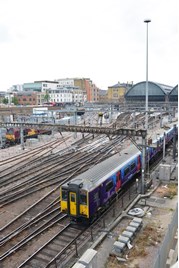 Read the peer reviews for this feature.
Read the peer reviews for this feature.
Download the graphs for this feature.
Lewis Cubitt’s Italianate terminus for the Great Northern Railway at King’s Cross is a true gateway to rail services.
Four operators - two franchised and two open access (Virgin Trains East Coast, Great Northern, Hull Trains and Grand Central) - run from the station, and there are proposals for a third open access service to join them. They sally forth on just four tracks, dipping sharply in Gasworks Tunnel to run under Regent’s Canal before lines from Canal Tunnels merge in from the left, to be followed a little later by Moorgate lines coming from the right.
Both junctions add more trains to the route (those from Canal Tunnels from 2018), making the line busy with many trains. This congestion has prompted major improvements in the past - notably in the 1950s, when British Rail quadrupled the line through Hadley Wood, ten miles north of King’s Cross. More recently, Network Rail has added capacity between Finsbury Park and Alexandra Palace to create three passenger lines in each direction. Two then diverge at ‘Ally Pally’ to leave four on the East Coast Main Line itself.
But BR’s work left a two-mile section through Welwyn North as double-track and that provides the major constraint on the southern section of the route today. In the past there has been talk of quadrupling this section, but no current proposals are on the table. Such a project would be very expensive, and will very likely draw complaints about spoilt views of and from the magnificent Welwyn viaduct.
NR describes the Welwyn section as a bottleneck that limits services to 18 trains per hour. But back in 2010 it reckoned it was not worth adding extra tracks, saying: “The four-tracking of the Welwyn viaduct is not expected to resolve capacity constraints on the southern end of the route. Four-tracking would allow trains calling at Welwyn North to use the slow lines, providing an approximate two to three trains per hour increase in fast line capacity.”
Such a constraint could be tolerated, were it not for the pressure from the line’s current and prospective operators for more paths in which to run more services.
Thameslink is set to expand as a result of a £6.5 billion project to boost the number of north-south trains running through London, with Great Northern trains to Peterborough and Cambridge being added to today’s Bedford-Brighton service. This is a government project, with ministers providing much of the money and shaping the service they expect in return.
Stagecoach and Virgin took over long-distance ECML operations earlier this year (branded as Virgin Trains East Coast), promising government £3.3bn over the life of the franchise. This commitment is predicated on increasing the number of trains running, with new destinations being added to the route map.
The East Coast Main Line is the only long-distance route upon which open access has taken hold. Hull Trains was the pioneer, starting in 2000, and it now runs six return services a day. Majority owned by FirstGroup, it’s driving forward an overhead wiring scheme to Hull so that it can run electric trains in place of today’s Class 180 diesels.
Coming slightly later was Grand Central, which began a Sunderland-London service in 2007 and then added West Yorkshire trains to Bradford from 2010. Owned by Germany’s DB, GC and its sister company Alliance now want to expand its Yorkshire services and run hourly fast trains to Edinburgh, likely using Class 390 Pendolino electric multiple units (as Virgin uses on West Coast services from Euston).
FirstGroup also wants to run five daily London-Edinburgh trains, to compete with the air market - calling at Stevenage (for Luton and Stansted Airport custom) and Morpeth (for Newcastle Airport).
When the ambitions of all these operators are rolled together (see panel), this, bluntly, is more than the line can cope with, according to studies conducted by Network Rail.
Broadly, there is demand for nine or ten long-distance, high-speed (LDHS) paths per hour, but capacity for only eight. In these terms, the two to three extra paths that in 2010 NR said Welwyn quadrupling would provide appear sufficient, even though NR dismissed this option as inadequate.











